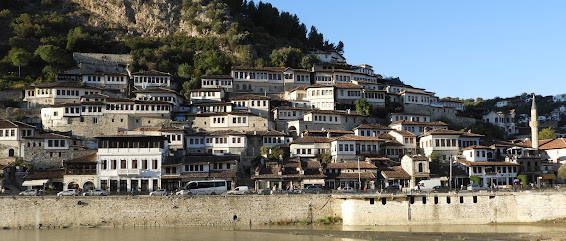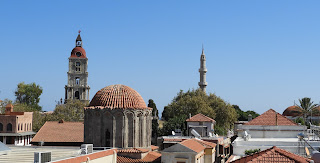 |
| view of Santorini's caldera |
 |
| Blue Mosque, Istanbul |
We’re in Istanbul at the end of a trip to Greece, Albania and Istanbul. We’ve flown Aegean Airlines, which we’ve never flown before, and Turkish, which we’ve flown many times, all over Turkey and Central Asia, for many years. I’ve had great experiences and always recommended Turkish to other travelers. Until now. Never again will I recommend them nor will I fly Turkish unless I have no other choice.
Booking logistics:
I booked our flights to Athens and home from Istanbul on United because both Aegean and Turkish are Star Alliance partners, so booking on United was easier and cheaper than booking 3 different itineraries. Plus, when United changed our flight from Denver to London by 3 hours, it also automatically changed our flight from London to Athens on Aegean. United gave me locator numbers for both Aegean and Turkish flight segments in addition to United’s locator number.
We flew
Aegean 6 times, from London to Athens, Athens to Santorini and back, Athens to
Rhodes and back, and Athens to Tirana, Albania.
I booked the London to Athens flight on United and the rest on Aegean’s
website.
I booked Tirana to Istanbul on Turkish Airlines’ website and
Istanbul to London, as part of our round trip, on United’s website.
Why I'll never recommend or fly Turkish again:
First, the bad news.
Turkish canceled its flight from Tirana to Istanbul and moved us to Air
Albania, which it said was a partner and code share airline. When I tried to book seats using my Turkish
reservation, Turkish told me they couldn’t book the seats because it was a code
share flight, not a Turkish Airlines flight. Air Albania said they couldn’t
reserve the seats because it was a Turkish reservation. I was not able to check in on either Turkish
or Air Albania websites, so had to wait in line at the airport in Tirana to get seats and boarding passes.
I tried tor 2 months to reserve seats on our flight from
Istanbul to London, the one I booked as part of our round trip on United’s
website. Turkish customer service, if
you can call it that, insisted they could not reserve seats because it was a
United reservation. United said they couldn’t
see a seat map for Turkish—and the Turkish website told me that I could not
access my reservation on their website even with their locator code.
I even went to 2 Turkish customer service agents at the
Istanbul airport and both told me I could not reserve seats or check in online,
despite having the Turkish locator number, because I’d booked via United. This, of course, is ridiculous as every other
partner airline I’ve used can let you reserve seats and check-in online or by
calling their customer service representative.
Consequently, we had bad seats at the back of the plane on a seriously
overbooked flight from Istanbul to London (at least we had seats).
Contrary to all our past experiences, Turkish customer agents
and flight attendants were surly and rude.
Not an experience I want to repeat when there are much better choices
for flying.
Why I'll recommend and fly Aegean from now on:
Now, to the good news.
Aegean Airlines was terrific to fly.
We flew a total of 6 flights on Aegean and had a great experience on
every one of them, from booking to selecting seats online to checking in online
to actual flying. Their website is easy
to use and, if you have to call them, their customer service agents are
helpful.
I always book seats in advance because, if you don’t do, you can get to the airport and find that your flight is oversold and you
don’t have a seat. Booking seats in
advance on Aegean was very easy. For the
flight I booked via United, I simply used the Aegean locator number United
provided and my reservation came up with all the options I needed for the
flight. Check in was very simple, as well. I added the Aegean app to my phone and the
boarding passes popped up as soon as I checked in. No fuss.
For the flights I booked on Aegean, I booked seats on their
website and checked in easily on their app on my phone. The airport staff were helpful and pleasant
and the flight attendants, likewise.
Our plane from Rhodes to Athens had a mechanical problem and couldn't fly. Rather than cancelling the flight, as most
airlines would do, Aegean flew in another plane, so, amazingly, we landed in
Athens only an hour late. I’ve never
seen that kind of operations readiness and customer service before on any
airline.
Whenever I travel in this region again, I will avoid Turkish
and fly Aegean. The former is unprepared
and unprofessional while Aegean provided excellent service.




















































